![]()
![]()
![]()
Use LEFT and RIGHT arrow keys to navigate between flashcards;
Use UP and DOWN arrow keys to flip the card;
H to show hint;
A reads text to speech;
81 Cards in this Set
- Front
- Back
|
black-figure |
Invented in Cornith; Technique of decorating pottery with black painted silhouettes against unpainted or burnished clay, with incised details and a restricted number of secondary colors (chiefly purple, white and yellow) |
|
|
Attika (Attic) |
(Of the) region around Athens |
|
|
Lakonia (Lakonian) |
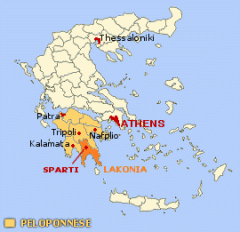
Region around Sparta |
|
|
Herakles |
Most popular hero of the Greek world (a Panhellenic hero that is sometimes associated with the city of Thebes and the Argolid); usually shown wearing a lion skin and wielding a club, or sometimes a bow |
|
|
Cerberus |
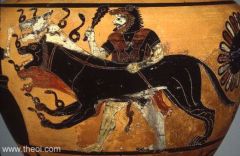
The monstrous guard dog of the Underworld |
|
|
Exekias |

An ancient Greek vase-painter and potter who worked mainly in the black-figure technique (Achilles and Ajax playing dice; suicide of Ajax) |
|
|
Amasis Painter |
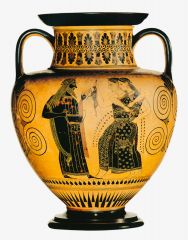
An ancient Greek vase painter who worked in the black-figure technique; 132 vases have been attributed to this artist |
|
|
Kleitias |
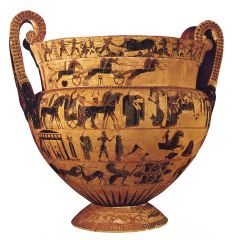
An ancient Athenian vase painter of the black-figure style; his most celebrated work today is the Francois Vase |
|
|
Francois Vase |
A large Attic volute krater decorated in the black-figure style which bears over two hundred figures in its six friezes; a milestone in the development of Greek pottery |
|
|
Centauromachy |
A fight in which centaurs take part ( a common theme for relief sculpture; a battle between centaurs or between centaurs and men |
|
|
pathos |
pity; the quality or power of something to evoke a feeling of pity, or of sympathetic and kindly sorrow or compassion |
|
|
palmette |
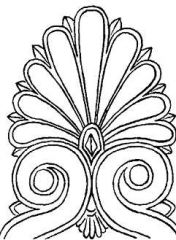
A decorative motif resembling a palm leaf |
|
|
aulos |
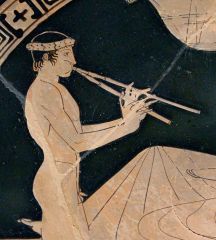
An ancient Greek wind instrument, depicted in art and also attested by archaeology |
|
|
eye-cup |
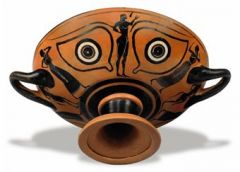
Drinking cup with eyes on the exterior; resembles a mask when raised to the lips |
|
|
tondo |
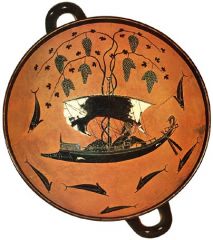
A round illustration found at the interior base of a kylix; a hidden narrative revealed when one has finished all their wine |
|
|
volute krater |
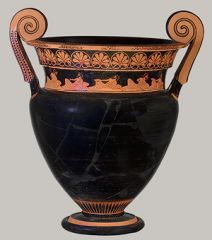
A large, deep bowl with spiral handles; used for mixing wine and water |
|
|
kylix |
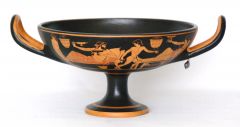
Type of wine- drinking cup with a broad relatively shallow body; the interior base of this drinking vessel was called the "tondo" |
|
|
Potnia Theron |
"Mistress of Animals"; a term used to describe female divinities associated with animals |
|
|
kore (korai) |
A popular type of Archaic statue: a young woman, clothed, standing stiffly with one arm at the hip, the other holding something either to the breast or with forearm extended forward; feet can be together of slightly offset |
|
|
kouros (kouroi) |
Archaic statue: a nude or semi-nude youth, typically standing stiffly with arms at or near the sides, and one foot (usually the left) extended forward; counterpart is the kore |
|
|
peplos |
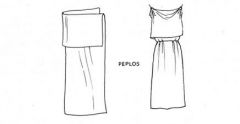
Dorian garment for women, made of wool; a rectangle of cloth that is folded in half lengthwise and then pinned at the shoulders and belted just above the waist |
|
|
chiton |
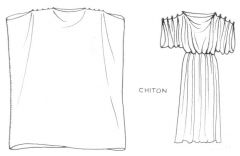
Distinctive Ionian garment made of linen; resembled a large pillow case and buttons along the upper edge |
|
|
Deme |
Suburb of Athens or a subdivision of Attica, the region of Greece surrounding Athens; they functioned to some degree as a polis in miniature and held their own religious festivals and collected and spent revenue |
|
|
Kerameikos |
An area of Athens located in the northwest of the Acropolis, which includes an extensive area both within and outside the ancient city walls on both sides of the Dipylon Gate |
|
|
Dipylon |
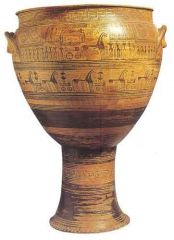
A gateway on the west side of ancient Athens, near which pottery has been found; an elaborate stage of ancient Greek pottery that uses the geometric style elements to illustrate funerals |
|
|
Paros |

A Greek island in the central Aegean Sea that lies to the west of Naxos; known for its fine white marble |
|
|
Delos |

A Greek island in the South Aegean Region; the birthplace of Apollo and Artemis |
|
|
Naxos |
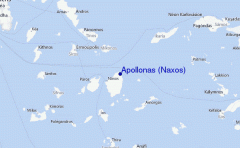
A Greek island that is the largest of the Cyclades island group in the Aegean |
|
|
Doric Order |
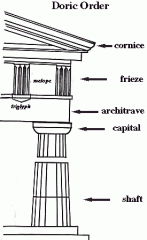
The oldest and simplest of the main orders that is characterized by heavy fluted columns with plain, saucer-shaped capitals and no base |
|
|
Ionic Order |
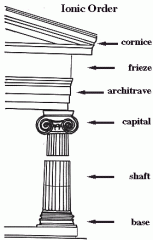
One of the three orders of classical architecture; characterized by two opposed volutes in the capital |
|
|
stylobate |

The floor upon which columns stand |
|
|
krepis (krepidoma) |

The platform on which the superstructure of a building is erected |
|
|
column |
An upright pillar, typically cylindrical, that supports an entablature, arch, or other structure (In the Doric, Ionic or Corinthian Order) |
|
|
flute (fluting) |
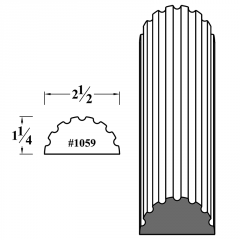
A long, straight groove running along the length of a column, roughly semi-circular in section |
|
|
capital |
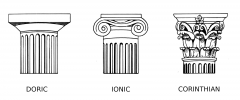
Elements crowning a column and supporting the architrave |
|
|
echinus |
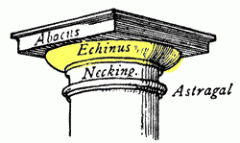
Distinctive cushion-shaped part of a Doric capital, just below the abacus |
|
|
abacus |
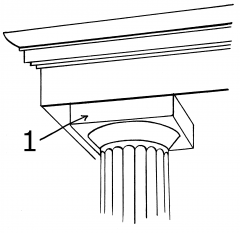
A flat slab forming the uppermost member or division of the capital of a column, above the bell |
|
|
volute |
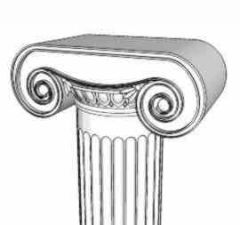
Spiral in architecture, the distinctive lower part of an Ionic capital, just below the abacus |
|
|
entablature |
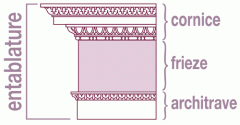
Everything between the top of the columns and the bottom of the roof; architrave plus frieze |
|
|
epistyle/architrave |

The horizontal blocks resting atop the columns |
|
|
frieze |
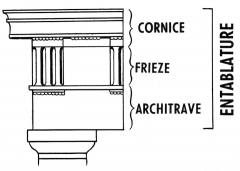
A horizontal zone running the length of a building immediately above the architrave |
|
|
metope |
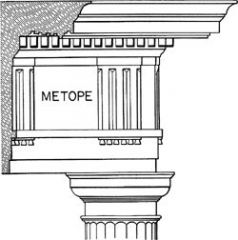
Square or rectangular panel, part of a Doric frieze; alternates with triglyphs -Can be decorated with paint or relief carving |
|
|
triglyph |

Grooved panel, part of a Doric frieze; alternates with metopes |
|
|
mutule |

A stone block projecting under a cornice in the Doric Order |
|
|
apotropaic |
A symbol or image used to avert evil influences or bad luck (example: use of the gorgon Medusa's head on shields and temples) |
|
|
knielauf |
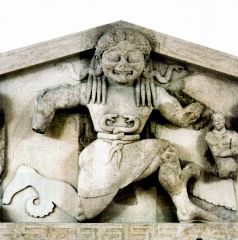
A stance to illustrate that a figure is running |
|
|
gutta (pl. guttae) |
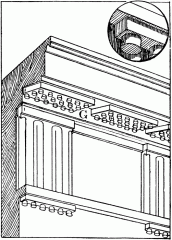
Element of the Doric Order; cone-shaped projection used in the architrave- attached to the regula |
|
|
regula (pl. regulae) |
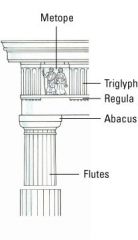
An architectural band or fillet beneath the taenia, in line with the triglyph above, from which guttae hang in the Doric entablature |
|
|
gieson (=cornice) |
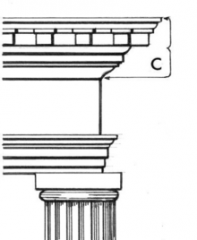
The part of the entablature that projects outward from the top of the frieze and forms the outer edge of the roof; the horizontal cornice of a pediment |
|
|
sima (=gutter) |

Low barrier along a roof line to keep roof tiles from sliding off; typical of West Greece |
|
|
antefix |
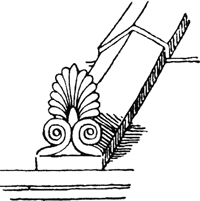
Upright element along a roof line which keeps the roof tiles in place; typical of mainland Greece |
|
|
pronaos |

A vestibule at the front of a classical temple, enclosed by a portico and projecting sidewalls |
|
|
cella |
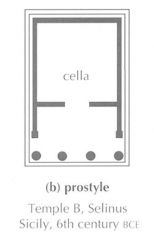
The inner chamber of a Greek or Roman temple that housed the cult statue/image of the deity |
|
|
opisthodomos |
The rear room of an ancient Greek temple |
|
|
adyton |
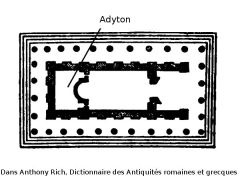
The innermost chamber of a temple |
|
|
pteron (peristyle) |

Row of columns running around all four sides of a temple or a courtyard |
|
|
distyle in antis |
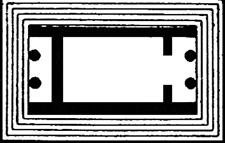
Ground plan with two columns in the front porch only |
|
|
hexastyle |
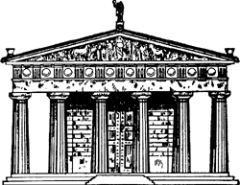
Having six frontal columns in the portico |
|
|
octastyle |
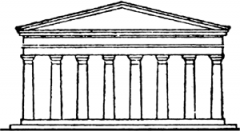
Having eight frontal columns in the portico |
|
|
peripteral |
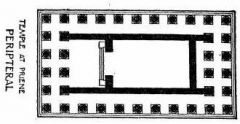
Having a single row of pillars on all sides in the style of the temples of ancient Greece |
|
|
dipteral |
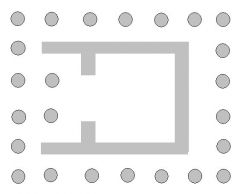
Ground plan featuring a double set of columns running around all four sides of a building |
|
|
in antis |

Having a recessed portico with a row of columns between the antae |
|
|
pan tile |
Flat roof tile |
|
|
cover tile / capping tile |
Curved or angled roof tile which covers ("caps") the gaps between pan tiles |
|
|
Delphi |
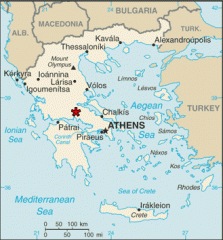
In the western spur of Mount Parnassus in the valley of Phocis; a panhellenic sanctuary that houses the Temple of Apollo and hosted the Pythian Games |
|
|
Phocis |
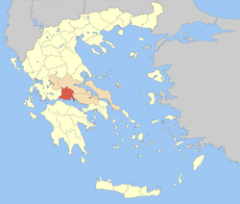
Phocis was an ancient region in the central part of Ancient Greece, which included Delphi |
|
|
Boiotia |
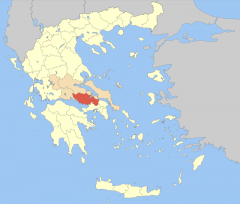
An ancient region of Greece north of Attica and the Gulf of Corinth |
|
|
Mt. Parnassos |
A mountain of limestone in central Greece that towers above Delphi and offers scenic views of the surrounding olive groves and countryside |
|
|
Siphnos |
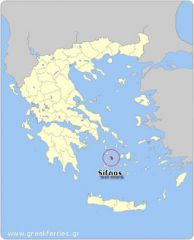
A Greek island that was very wealthy in ancient times, thanks to its gold, silver, and lead-Proof of this is the treasury which this island built at Delphi in the 6th century BCE to house their offerings |
|
|
temenos |
A temple enclosure or court in ancient Greece : a sacred precinct;a piece of land cut off and dedicated to a god, a sanctuary, holy grove or holy precinct |
|
|
amphictyony |
An association of neighboring states in ancient Greece to defend a common religious center, such as the sanctuary at Delphi |
|
|
oracle |
A god who predicts the future, like Apollo; a priest who hears the prediction/message and the prediction itself, and the place where the priest hears the message |
|
|
Pythia |
Commonly known as the Oracle of Delphi and was widely credited for her prophecies inspired by Apollo; the name of any priestess throughout the history of Temple of Apollo at Delphi |
|
|
Sacred Way |
At Delphi, the path that reaches up to the temple of Apollo and then leads up to the theatre and the stadium; treasuries from various Greek states can be found on this path |
|
|
caryatid |
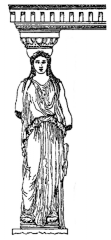
A column that takes the form of a kore |
|
|
treasury |
Built by states in Greece and overseas as repositories for valuable offerings and equipment for embassies; were small and tended to be especially fine and showy |
|
|
chthonic |
Having to do with the Underworld; things underground and the fertility and richness of the earth |
|
|
Gigantomachy |
A battle between gods and giants in Greek mythology |
|
|
Theseus |
Ancient king of Athens who became important in the 5th century as a counterpart to Herakles; an Athenian hero who completed many labors such as slaying the Minotaur |
|
|
chryselephantine |
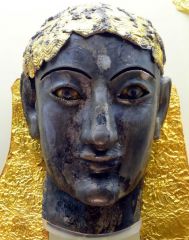
Made of gold and ivory |
|
|
Gaia |
Mother earth or Mother nature; personifies the entire ecosystem of planet Earth |

